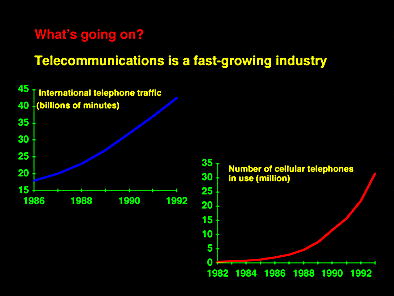
Telecommunications Sector: Background and Bank Group Issues
Part
1: What's going on in the telecommunications sector?
Part 2:
Where do our clients stand?
Part 3: What
actions are needed?

Telecommunications is a fast-growing industry by any measure. For example, international telephone traffic has been expanding for the last ten years at about 16 percent per year, about four times the pace of the global economy.
The cellular telephone business, which was only beginning twelve years ago, now has more than 30 million customers worldwide.
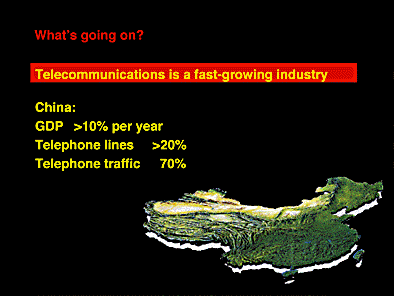
Another example of fast growth is China: while its economy is growing at over 10 percent per year, telephone lines are increasing at more than 20 percent and telephone traffic at about 70 percent per year.
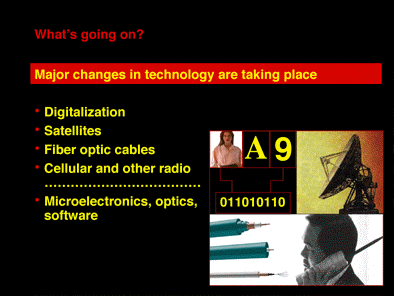
Fast growth is associated with rapid changes in technology.
Digital electronics are replacing earlier analog electronic and electromechanical solutions with much more functional, compact equipment that enables efficient network utilization.
Satellites give independence from distance; introduced in the 1960s for international communication, they are now extensively used also for domestic and corporate networks.
Fiber optic cables bring high transmission capacities at virtually zero marginal cost per unit of traffic.
Cellular, cordless, and other radio systems allow flexible and mobile connection of the end customer.
At the root of these technologies are microelectronics, optics, and software--the technology of computers--which augur further change.
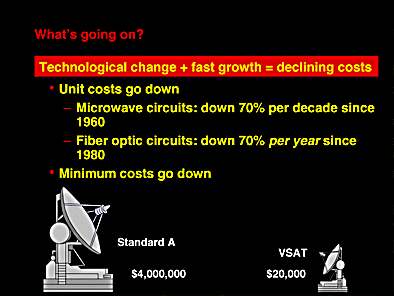
Technological change coupled with fast growth results in declining costs. Unit costs go down; for example, the cost per voice channel of microwave equipment declined 70 percent per decade since 1960; with the advent of fiber optic cables, costs per circuit have been plummeting at about 70 percent per annum since 1980.
Entry costs also go down. For example, 30-meter diameter standard satellite earth stations in the 1970s (and today) cost about $4 million; 1-meter diameter very small aperture terminals (VSATs) are available today for about $20,000. True, these stations have very different capacities, but the point is that today one can do business in satellite communications with a fraction of the capital needed in the past.
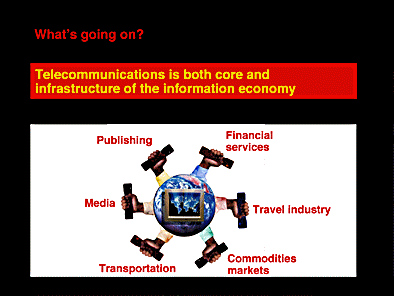
Technological change has opened the way for a wide range of solutions for developing telecommunications systems. Whereas just a few years ago there was generally only one cost-effective manner to develop a given network, today there is a wide range of choices. For example, following German reunification Deutsche Bundespost Telekom chose a fixed version of cellular telephones to upgrade priority business and government customers in the East within a few months, rather than wait over a year to connect them using conventional wire line technology. In Madagascar domestic satellite links are being used to extend service to towns separated from the main cities by rugged terrain that would make traditional cable and microwave solutions slow and costly.
This diversity of network options, in turn, has enabled changes in market structures. Monopolies are being eroded, competition is building up, and opportunities for private business are multiplying. More on this later.

All of this matters for development because information has become a fundamental factor of production, alongside capital and labor. About one-half of the output and employment in OECD economies comes from handling information (as distinct from goods). Already in the 1970s over 20 percent of GDP in some developing and newly industrialized countries came from information; today's figures are likely to be much higher. Demand for information processing and transmission therefore has increased dramatically.
Telecommunications is both the core and infrastructure of the information economy. Core because major economic activities are themselves mostly information processing and transmission (e.g., financial services, commodities markets, media), and other depend critically on these facilities (e.g., publishing, transportation, travel). Telecommunications itself has become a large and rapidly growing business--telecommunications operating revenues worldwide probably exceed $500 billion, which is roughly equal to the GNP of Canada or 2 to 3 times that of Africa. Infrastructure because telecommunications facilitates market entry, improves customer service, reduces costs, and increases productivity in all sectors.
The garment industry, with global sales of $100 billion, offers an illustrative example. When a clerk at a retail franchise in Tyson's Corner, Virginia rings up the sale of a shirt, the information is automatically transmitted to the main computer at the company's headquarters in Europe, where demand and sales are assessed. Orders are sent to the textile mills (perhaps in Indonesia) to produce the materials and ship them to assemblers (perhaps in the Philippines and Sri Lanka), from where the final product is shipped in small batches directly to the retailer in Tyson's Corner. With these telecommunications links the restocking cycle is completed in about 30 days. Countries without these links cannot effectively participate in global trade.
In conclusion, telecommunications has become a strategic investment to maintain and develop competitive advantage at all levels the firm, the region, and the country. Countries and firms that lack access to modern telecommunications services can no longer effectively participate in the global economy.
Telecommunications systems have been effectively deployed in the extension of social services and regional development. They have been used to support human resource development through distance education and training; to facilitate health services in rural areas through linkages to interactive medical information networks; to extend and consolidate government administration to regions; to enhance agricultural development and resource management by enabling farmers to access such information as market trends, weather reports, and modern growing techniques; and to support the mobilization of aid for disaster relief operations, among other things.
Since new technologies such as wireless local loops and satellites are promising cost-effective capabilities to access remote areas, the use of telecommunications systems for promoting regional and economic development is likely to intensify in the future and help alleviate poverty in developing countries.
An example of social applications of telecommunications is the University of the West Indies Distance Teaching Experiment (UWIDITE). Developed in the early 1980s with USAID funding, UWIDITE was the first full-scale telephone-based conference system used for academic training in the developing world. It served 14 Caribbean nations, three main campuses in Jamaica, Barbados, and Trinidad, and eleven small university centers.
Through a hybrid satellite/microwave/cable system using the existing capacity of the telecoms networks, programs are broadcast from the main campus in Jamaica via the Intelsat 4 satellite to Trinidad, re-routed through the local system and a microwave link to the network bridge at St. Lucia, then transmitted using microwave signals to other islands.
A USAID assessment concluded that the project achieved all of its original objectives while realizing major cost savings. A one-day seminar using the teleconference system cost just $1,000, compared to more than $11,000 for a face-to-face program. Use of the system has also evolved over time to cover other social services, including health programs in fertility management, family planning, and cardiology as well as training of community workers in agriculture, education, health, and public administration.
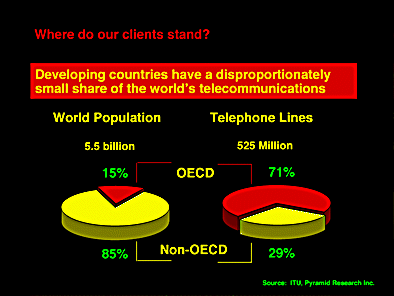
Developing countries have a disproportionately small share of the world's telecommunications facilities. For example, countries outside the OECD have 85 percent of the global population but less than 30 percent of all telephone lines. The low-income countries in Asia have 50 percent of the world's population but only about 5 percent of lines.
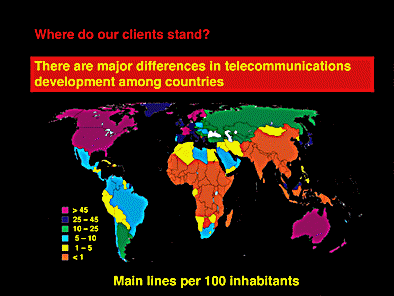
There are major differences in telecommunications development among countries. Latin American countries, with about 10 telephone lines per 100 inhabitants, have some of the developing world's largest telecommunications operating companies (e.g., Brazil 12 million lines, Mexico 7 million, Argentina 4 million). Basic service is fairly widely extended, and there is a vibrant modern economic sector demanding advanced telecommunications services.
By contrast, sub-Saharan Africa averages less than 1 telephone line per 100 inhabitants; several countries still have only 1 per 1000. Service is concentrated in a few cities; for example, about 80% of Kenya's population lives in places that have no telephones. There are dire shortages of skilled labor and virtually no capital markets on which to base rapid sectoral improvement.
Asia ranges from huge and rapidly expanding markets (e.g., China, and potentially India and Indonesia) to small countries in the early stages of system development (e.g., Laos, Nepal, Sri Lanka). Some of the world's most sought-after emerging telecommunications investment markets are in Asia.
The CIS and Central/Eastern Europe appear relatively developed, but past allocations of investment have followed political rather than market signals, so the system impact is less than numbers suggest. Also, there are big technological gaps with respect to the West. Modernization, rather than growth, is the main goal.
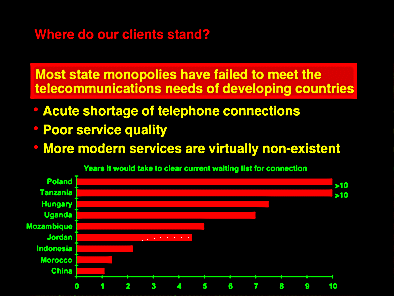
Unlike in Europe, Japan, and several other countries, state monopolies in developing countries have generally failed to meet telecommunications demand. Widespread shortfalls include acute shortage of telephone connections (e.g., waiting times up to 10 years and more to obtain a new telephone line, compared with days or weeks in developed countries), poor service quality (in many countries it is virtually impossible to get through by telephone during peak business hours), and an absence of more advanced services (such as facsimile, data transmission, electronic mail).
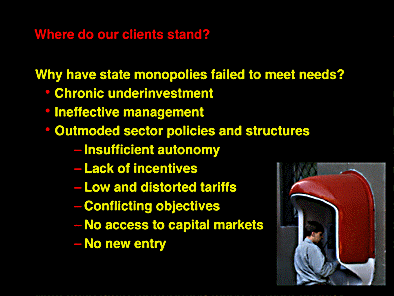
These shortfalls have three main (inter-related) causes. First, despite high economic and financial returns from investment (typically 30 and 20 percent, respectively, for Bank-supported programs in the 1980s), telecommunications suffers from a general shortage of state funds for investment, many competing demands (e.g., for more schools and hospital beds), and government appropriation of telecommunications operating surpluses for uses other than reinvestment. And given its high requirements for imported equipment, telecommunications is critically dependent on foreign currency funds.
Second, telecommunications entities are organized and managed more like parts of government administrations, rather than as customer-oriented, market-driven, technology-intensive, rapidly-changing businesses.
Third, telecommunications entities are weighed down by lack of autonomy and incentives to perform, low and distorted tariffs, objectives (e.g., employment, health, housing, social security) that conflict with the main business, and lack of access to capital markets. And--most importantly--no new entry is allowed, despite the incumbent's inability to meet demand.
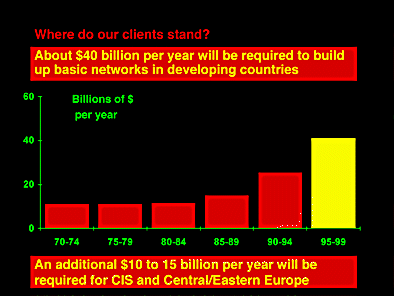
Given the wide gap in telecommunications development between LDCs and the industrialized world, it is clear that huge amounts of investment in the sector are necessary. About $40 billion a year must be invested by LDCs for the next six years to build up the basic telecommunications infrastructure. This figure does not assume that by the year 2000 these countries will reach the same telephone penetration rates as the industrialized world, nor does it include the $10 to $15 billion of investment per year that will be required for the CIS Republics and Central and Eastern Europe.

Where will all this capital come from? In the 1980s, about 65 percent of telecommunications investments in developing countries were financed from funds generated by the operating companies themselves, about 15 percent from official sources (mainly bilateral and multilateral credit and aid, export development credits, and own government contributions), and about 20 percent from private sources (mostly commercial bank and supplier-arranged loans for creditworthy countries).
If a major increase in total funding is to materialize, about one-half of the much larger total for the 1990s would have to come from private sources. This requires creating conditions to attract direct private investment and accessing domestic and foreign capital markets. About 40 percent of the necessary funds could still come from internal cash generation (a substantial increase in funds although a smaller proportion). This stresses the need to make operations profitable and efficient. Official sources are unlikely to provide more than about 10 percent (even this would imply substantial absolute increases). This signals the need to use official funds mostly to catalyze private investment and improved performance.
Realizing the opportunities and the need to overcome persistent past shortfalls, a growing number of our client countries are reforming telecommunications sector policy and structure along three main avenues: commercialization of operations, encouraging new entrants and competition, and increasing private participation. The role of government is thus shifting from ownership and management of operations to sector policy and regulation.
It is now widely accepted that telecommunications operating entities perform best when they are run as commercial, for-profit businesses. Commercialization involves distancing operations from government, thus subjecting the entity to the freedoms, incentives, and disciplines of the market. Commercialization also involves changing internal organization and management to enable the entity to respond to these new conditions.
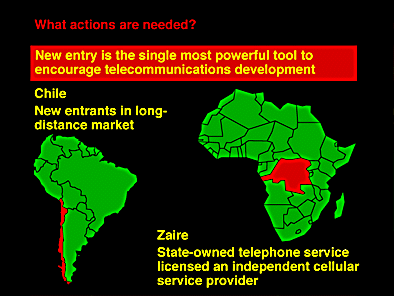
There is growing evidence that new entry results in improved and new services, wider choices to users, additional capital and management skills, and lower costs. For example, while Chile's main local telephone company (CTC) and the main long-distance carrier (ENTEL) have been battling over CTC's direct access to the long-distance and international markets, a third company (Chilesat) has developed its own satellite and fiber optic networks and now carries about 40 percent of Chile's outgoing international traffic. ENTEL has since reduced tariffs on these routes by about 50 percent in real terms.
In Zaire, where the antiquated wire line network is controlled by the government, a cellular company that was licensed a few years ago has become today an important provider of telephone services. It succeeded in leapfrogging technologies by using the latest in satellite and cellular communications to provide wide coverage while turning a profit.
In most developing countries, growth is a more urgent objective than efficiency. Where the incumbent's networks meet only a small fraction of total demand, new entry is likely to have a greater impact on meeting demand than improving the incumbent.
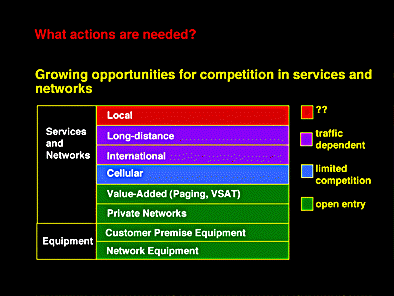
Technological and market changes are gradually making competition economically viable throughout the sector. In some segments (network and customer equipment, private networks, value-added services), open entry is beneficial to all. In others (e.g., cellular), availability of radio spectrum capacity (a reusable but finite natural resource) currently limits the number of operating companies in a given territory to about four. The extent to which competition is viable in some core business segments (e.g., long-distance and international voice communication) varies with the volume and growth rate of traffic. In the local telephone network, accounting for about one-half of total investment, prevailing natural monopoly features are being challenged by fixed applications of cellular, cordless, and other wireless technologies. Competition policy must be tailored to each country.
New entrants can be brought in by dividing existing monopolies into regional operators (as was done in Argentina); opening new services to new providers rather than burdening an incumbent unable to meet demand for existing services; encouraging railways, power, and other corporate net-works to interconnect with the public network, lease capacity to each other, and offer public service in their areas.
Liberal entry and pricing policies are likely to be important tools to extend service to rural areas. A 1980s study in Brazil found 400,000 farmers and cooperatives willing to pay the full cost of connection to the national telecoms network; the state enterprises, however, had neither the freedom to charge these users the full cost nor the funds to connect them for less. A recent study in Pakistan found that a large national rural telecoms program would be moderately profitable; this suggests that local or regional entre-preneurs could find business opportunities in many rural areas if allowed to.
Once the market has been allowed to run its course, some areas that are not commercially viable may still need to be connected. At that time the amount of subsidy needed, and who would pay, can be addressed. In many countries the residual that needs subsidy is likely to be quite small.
Private participation is essential to accelerate telecommunications growth. The need for large amounts of private investment was illustrated in Part 2. There is growing evidence that, where properly implemented, private participation in telecommunications leads to faster growth, improved management, access to technology and capital markets, and welfare gains by most or all stakeholders (customers, workers, governments, investors). This is consistent with the Bank's experience in other sectors. While treasury concerns for the loss of control of telecommunications surpluses sometimes work against privatization initiatives, experience so far indicates that fiscal revenues actually increase, sometimes quite dramatically, as the telecommunications sector grows faster under private management and financing. Other benefits to treasuries have included large proceeds from sales and reduction of sovereign debt through swaps.
There are many ways to increase private participation in telecommunications. Chile, Argentina, Mexico, and Venezuela privatized their former state telecoms operating enterprises by first selling controlling or majority interests to experienced and financially strong investors, followed by public offerings once the companies appreciated under private management.
Build-operate-transfer arrangements, as they are being used to more than double system capacity in Thailand, are a way to increase private participation without privatizing the incumbent state operator. In Poland, the main telecoms enterprise remains in the public sector, but a number of private regional and rural operators have been licensed to compete with it. At a more modest level, state enterprises are increasingly contracting out to private companies such non-core functions as construction, cable laying, equipment installation, billing, collection, and directory publication.
Some countries with favorable macroeconomic conditions (e.g., Malaysia, Singapore) have successfully attracted private investment to state-controlled (and highly commercialized) companies through the sale of minority shares and placement of long-term debt in local markets, where they quickly became some of the largest traded companies.
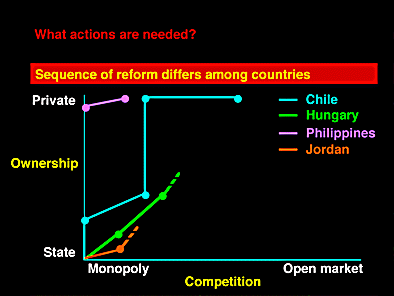
There is no universal blueprint for reform. Chile began with minority private telecommunications entities. It then licensed cellular and new small operators before privatizing the main entities entirely. Now there is also competition for long-distance service.
The telecommunications operator in Hungary was state-owned when reforms were first undertaken.The first move was to make it a 100 percent government-owned joint-stock company and enter into a cellular joint venture with a foreign operator. Recently a controlling share (30 percent) of the company was sold to a foreign strategic consortium, and value-added services and several regional telephone companies were franchised. More private participation and competition are expected in the near future.
The main telecommunications entity in the Philippines has been a private monopoly for decades. The government has recently licensed other operators to compete with it.
Jordan has just begun its reform by issuing a tender for a cellular license; it intends to commercialize and then privatize operations with World Bank assistance.
Reform requires explicit government arrangements for sector regulation. While telecommunications operations are in the public sector, the political system serves, however imperfectly, to direct the course of the sector and resolve conflicting objectives and interests. As the enterprises are commercialized, private owners take over, and multiple providers enter the market, the government needs to formalize regulatory arrangements and institutional responsibilities. As in other sectors, the main objectives of telecommunications regulation are to promote investment, facilitate new entry, and protect the public interest. The means to do this involve various mixes of legislation, rules and regulations, contracts and licenses, and regulatory institutions.
There are practical limits to the extent and pace of telecommunications reform. Competition, for example, is conditioned by radio spectrum availability and market characteristics. Private participation cannot materialize without an appropriate national legal framework and other features that contain country risk to the investors. The regulatory arrangements that are possible depend on the country's political system and institutional endowment. It is thus often necessary to settle for very imperfect solutions.
Reform is a dynamic process. Although singular events can be completed rapidly, the necessary groundwork takes typically 3 to 5 years, during which substantial technical and financial support is needed. For example, in Argentina, where privatization of the state enterprise was completed in 1990 (in less than two years), the reform process had begun in 1986 and arguably is still not complete today as major flaws in the regulatory arrangements remain unsolved.
In some cases, reform decisions will bring results only gradually. Private financing may not flow in immediately, regulation and competition will often progress much more slowly than privatization, and sustained growth will ultimately depend on building up domestic capital markets, investors' perceptions of country risk, and general economic developments in the country.. Governments will need to establish a track record of abiding by their rules and agreements.